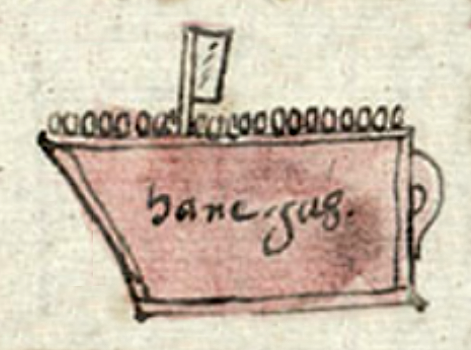cempohualli fanegas (CST40)
This painting of the simplex glyph for the term fanega (here spelled hanega, referring to a measure of grain equaling about a bushel and a half), shows a frontal view of what is probably a wooden container facing toward the viewer’s left. It has a handle on the right end. An alphabetic gloss is written on the front side of the container telling that this is meant to convey multiple fanegas (plural). Wheat grains appear all along the top in a neat horizontal row. Sticking up from these grains is a vertical post with a rectangular flag flying toward the viewer’s right. Little lines on the flag give it a three-dimensional look. The flag represents the number twenty (cempohualli), which is confirmed in the companion text, counting twenty fanegas. This text also confirms that this was “Castilian maize,” or, in other words, wheat. Compare it, below, to maize kernels.
Stephanie Wood
For more on the Codex Sierra, see Kevin Terraciano’s study (2021), especially pp. 125 and 158 for the Nahuatl transcription and the English translation.
Stephanie Wood
cenpuali hanegas
cempohualli fanegas
Stephanie Wood
1550–1564
Jeff Haskett-Wood
agricultura, trigo, medida, fanegas, hanegas, granos

cempohual(li), twenty, https://nahuatl.wired-humanities.org/content/cempohualli
fanega, a measurement for maize kernels/seed, a bushel and a half, https://nahuatl.wired-humanities.org/content/fanega
veinte fanegas
Stephanie Wood
Códice Sierra-Texupan, plate 40, page dated 1561. Origin: Santa Catalina Texupan, Mixteca Alta, State of Oaxaca. Kevin Terraciano has published an outstanding study of this manuscript (Codex Sierra, 2021), and in his book he refers to alphabetic and “pictorial” writing, not hieroglyphic writing. We are still counting some of the imagery from this source as hieroglyphic writing, but we are also including examples of “iconography” where the images verge on European style illustrations or scenes showing activities. We have this iconography category so that such images can be fruitfully compared with hieroglyphs. Hieroglyphic writing was evolving as a result of the influence of European illustrations, and even alphabetic writing impacted it.
https://bidilaf.buap.mx/objeto.xql?id=48281&busqueda=Texupan&action=search
The Biblioteca Digital Lafragua of the Biblioteca Histórica José María Lafragua in Puebla, Mexico, publishes this Códice Sierra-Texupan, 1550–1564 (62pp., 30.7 x 21.8 cm.), referring to it as being in the “Public Domain.” This image is published here under a Creative Commons license, asking that you cite the Biblioteca Digital Lafragua and this Visual Lexicon of Aztec Hieroglyphs.




